Guided bombs for the Luftwaffe
Henschel Hs 293
There was a serious need for a new weaponswhich would combine a good range and excellent hit accuracy for that time. It should be noted that the general concept of such ammunition was proposed by engineer G. Wagner back in 1939, but then for a number of reasons it did not receive proper development. Wagner proposed to create a small similarity to a glider and equip it with control systems, a warhead, etc. In this case, the bomber could drop the bomb, being at a safe distance from the anti-aircraft cover of the target, and direct it using commands. The leadership of the Luftwaffe Wagner's proposal was of little interest. They did not give special preferences to the program, but did not begin to close it. The development of new ammunition began in the 40th at the Henschel company. The planning bomb received an index of Hs 293.
By December of that year several prototypes of the new bomb were ready. Constructively, they were a small mid-plane aircraft of the classical scheme. An explosive charge was placed in front of the bomb's hull, borrowed from the SC-500 - 300 aerial bomb, ammotol. In the rear part of the Hs 293, in turn, control equipment and tail assembly were installed. The trapezoidal wing span of the 3,1 meter was mounted in the middle of the bomb. Under the case of the bomb, the Walter HWK 109-507 model accelerator was suspended. As planned by the authors of the project, he had to give the bomb the initial speed required for a long-distance flight.
The first prototypes of Wagner’s planning bomb were in the Hs 293V-2 project version. The previous option - Hs 293V-1 - remained on the drawings and in fact became an advance project of a new weapon. On December 16 of 1940, the first test discharge of a guided bomb was made. As a carrier, a modified He-111 bomber was used. It installed radio control equipment, a sight for the navigator-scorer, through which he had to monitor the flight of the bomb, as well as a special heating system. The compressor and the heating element brought warm air inside the bomb so that all its systems would work normally. Despite all the efforts of designers and test pilots, the first bombing was unsuccessful. Separation of the Hs 293 from the carrier took place normally, the accelerator dispersed the bomb, but the navigator-bombardier was not able to get at least into the target area. Fortunately for Henschel, this was not the fault of the design. Just a certain worker at the assembly mixed up the connected wires. Because of this, the ailerons of the bomb began to work incorrectly - with the “roll to the left” command, the bomb raised the left wing and vice versa. Investigation of the causes of the incident did not take much time and the second test of the planning bomb, after appropriate checks, was carried out only two days after the first. This time everything worked normally and the bomb dropped in 5,5-6 kilometers from the conditional target fell into the area of the target drawn on the ground. Subsequently, several dozen training bombings were carried out.
In the course of further work on the project, the planning bomb Hs 293 underwent several design changes. So, almost immediately after the start of testing, new pyrotechnic tracers were installed at the ends of the wing consoles. They were intended to facilitate tracking the path of the bomb. It should be noted that the original tracers were quite suitable for developers and pilots in terms of brightness and visibility. But the duration of their burning left much to be desired. In the course of several test bombings, a situation developed when at the most crucial moment of their flight the bomb became practically invisible to the operator. And all because of the quickly burned out tracer. As a result, by selecting the composition of the mixture, the burning time of the checkers was brought to 110 seconds, which was considered sufficient for combat use. Another problem Hs 293 was in the accelerator. In tests, everything was more or less normal, but during combat operation a serious drawback of the Walter HWK 109-507 liquid engine was revealed. The fact is that the drill technicians could not provide the same “greenhouse” conditions as they were during the tests. In particular, a can of compressed air used to push fuel was often filled with simple atmospheric air. Due to the natural humidity of the injected air and temperature changes, some valves and valves often froze during the operation of the pneumatic system, as a result of which the fuel supply stopped. Reich ministry staff first aviation suggested using another BMW liquid accelerator. However, soon the idea of a rocket engine on a planning bomb was abandoned altogether and Hs 293 began to be equipped with a WASAG 109-512 solid fuel accelerator. According to its characteristics, it was close to the Walter engine, but did not have a tendency to suddenly stop working. Finally, just before the adoption of the Hs 293 bomb, its modification with control over the wire channel was created. Coils with thin cable placed inside the wing.
In the two years of testing (from the end of 40 to the end of 42), the combat performance of the new bomb was brought to excellent values. An experienced carrier crew could drop a bomb at a distance of 14-16 kilometers from a target at an altitude of 5-6 km and stack up to half of all bombs in a relatively small area around it. Of course, this could not be enough to defeat, say, a ship. But for those times, fifty percent of the hit when dumping at such a distance was an extremely successful indicator. At the beginning of 1943, the planning bomb Hs 293A was put into service and mass production began. In April of the same year, on the basis of the second group of the 100th bomber squadron of the Luftwaffe (II / KG100), the formation of a special aviation unit armed with a new guided munition began. The group used Dornier Do-217 bombers. Due to its characteristics, this aircraft could simultaneously carry two planning bombs at once. In late July, the 43-i II / KG100 was transferred to the coast of the Bay of Biscay to fight the Allied ships. At about the same time, Group II / KG40 was formed.
The first combat use of the Hs 293A bomb took place on 25 August 1943. Then a mix of 12 bombers found an English 40 escort group in the patrol zone. From a safe distance, the Germans dropped several bombs, but did not achieve much success. The sloops HMS Bideford and HMS Languard were slightly damaged, one sailor from the “Bideford” died. The reason for the failure of the Germans lay in the accuracy and technical problems. So, the bomb that got into “Bidford” did not detonate properly, and the four Hs 293A, which exploded next to the “Languard”, could not cause serious damage to the sloop due to a miss. Nevertheless, the capabilities of the new planning bomb were demonstrated in a real combat situation. Two days later, the English sloop HMS Egret and the Canadian destroyer Athabaskan were attacked. The German bomb landed the English ship directly into the artillery cellar. Egret sank. Canadian sailors were more fortunate - Etebascan received only heavy damage. For the year of combat use, unit II / KG100 with the help of planning bombs Hs 293A sank 17 of British and American ships and caused damage of varying severity to 15-te. It is noteworthy that the efficiency of the pilots II / KG100 and II / KG40 grew along with the number of combat applications. For example, from February to August of the 44, on account of both bomber groups, there was not a single damaged ship, but only a submerged one. The result of the raids of German bombers was the decision of the Allied Command to withdraw their ships farther from the Atlantic coast of Europe. Due to this, the German submariners were able to navigate the Bay of Biscay, almost without risking to be detected. The latest case of successful combat use of Hs 293A against ships relates to 15 August 44. Then the German pilots from southern France sank two American tank landing ships and damaged another. Due to the successful advance of the Allies in Western Europe, by the autumn of 44, the Germans had almost no opportunity to fly on patrols of the Bay of Biscay and other coastal zones. Finally, just the last combat use of the Hs 293A bombs occurred in April 1945. Trying to somehow delay the advance of the Red Army, the Nazis attempted to destroy several bridges across the Oder. Thanks to the opposition of the Soviet fighter aircraft, the bridges almost did not suffer. The offensive continued.
Based on the construction of the Hs 293 bomb, several modifications were developed:
- Hs 294. Initially anti-ship ammunition. Development began in the 1941 year in order to ensure the reliable defeat of enemy ships. The essence of the ideology of the project Hs 294 is that the bomb should fall into the ship below its waterline. To do this, the bomb hull received a new form, the wings were made dropable, and acceleration was carried out immediately by two accelerators. At the end of 1942, trials were started, and in all, according to some sources, about one hundred and fifty such bombs were collected. There is no data on combat use;
- Hs 295. An enhanced version of the Hs 293A. Almost all equipment and construction was updated. Thus, the bomb hull acquired more streamlined contours, radio control equipment was replaced with a more noise-resistant one, and one solid-fuel accelerator gave way to two. In 44, work began on equipping this bomb with a television guidance system, but this version of the Hs 295 was not even embodied in metal. A total of about 50 of such bombs was made, but the Germans did not have time to apply them in a real situation.
FX-1400
The development of G. Wagner fully suited the Luftwaffe in terms of combat effectiveness. As for the financial and technological side of the case, there were complaints. For mass production, a simpler design was required. Back in 1938, Dr. M. Kramer began experiments to improve the accuracy of the SC250 bomb. Like G. Wagner, he finally came to the conclusion that it was necessary to equip the bomb with serious guidance equipment. In 1940, Kramer's developments interested the Luftwaffe leadership and he was sent to continue building a new ammunition at Ruhrstahl. At the same time, the customers demanded an increase in the power of the warhead of the future guided bomb — like the Hs 293, the Kramer project should have been based on the existing aerial bomb. This time chose PC1400 caliber 1400 kg.
Given the characteristics of the original bomb, Kramer began to develop the appropriate "body kit" and control equipment. The result of the work on the project FX1400 or Fritz X was a new guided munition that looks significantly different from the creation of Wagner. The body of the Fritz X was molded from steel and in some places had walls up to 15 centimeters thick. In the middle part of the hull four wings were installed X-shaped, and in the back - tail plumage of the original form. Four planes in the shape of a plus (two keels and a stabilizer with a rudder) were closed with an oval piece of complex shape. Kramer also placed control equipment and a tracer at the tail end to facilitate the work of the bomb operator. Due to the presence of a tracer in the rear part of the hull, a version about a rocket engine appeared at one time, but did not have one in any FX1400 version. The thick walls of the bomb shell pushed the designers to the original idea of its use. The Fritz X bomb had to be dropped from a great height, at least 4000 meters. When falling, the bomb acquires a speed at which it can pierce the side of the ship and explode inside. For this reason, the bomb received a delayed fuse. Contact fuse was not provided.
The first prototypes of the FX1400 bomb were delivered to the test site near Karlshafen in February 1942. True, the weather conditions did not allow starting full-fledged tests. A few weeks were spent relocating the testers to Italy at the Foggia test site. Fritz X were assembled much more carefully than the first Hs 293 and the tests were quite successful. Most of the time was spent on training bomber operators and on working out the aircraft’s radio equipment and the bomb itself. By the fall of 42, test pilots were able to achieve the probability of hitting the target in 50%. It also turned out that if the bomb was dropped from a height of at least six kilometers, it was able to penetrate 130 millimeters of deck armor. The hitting of the FX1400 bomb into the ship — combined with the guidance system and detonation of the charge with a delay — was considered by the Germans almost no chance for the enemy’s sailors.
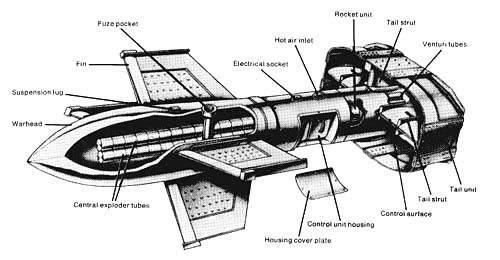
In the autumn of the same 42 of the year, on the basis of Granz, the 21 training and test command was formed. The purpose of its creation was the training of combatant pilots using the new ammunition. A little later, the 21-e command will be transformed into group III of the 100 bomber squadron (III / KG100). The “baptism of fire” Fritz X took place only at the end of July 1943. German pilots found several British ships in the roads of Syracuse and Augusta. Two attacks were carried out and both were unsuccessful. Further use of the new bomb was also not very successful. The fact that the high altitude was actually a problem: FX1400 could not be used in cloudy conditions below 4000 meters. The second snag in the application of the planning Fritz was in the electronic countermeasures of the British. Interestingly, there is still no exact data on the use of “jammers”. But it is known that the British attached to the EW more important than the Germans. However, Kramer, in 41, developed an alternative guidance system with the transmission of commands over the wire. Each bomb was supposed to have two coils: one on the console of the bomb, the other on the console of the aircraft carrier. The total wire margin was 30 kilometers for each bomb. The last problem of the FX1400 bomb, as it turned out, “grew” out of what was initially considered an advantage. High armor penetration was useful when attacking heavy ships like battleships. But merchant ships and even destroyers of a speeding bomb sometimes just pierced through. The fuse did not have time to react in time and the charge was exploded only when FX1400 was already in the water. Of course, such an explosion had no proper effect. Due to all of the reasons for the Fritz X bombs taken together, according to reports, only one ship was sank. It was the Italian battleship Roma. Five other Italian, American and British ships were only seriously damaged.
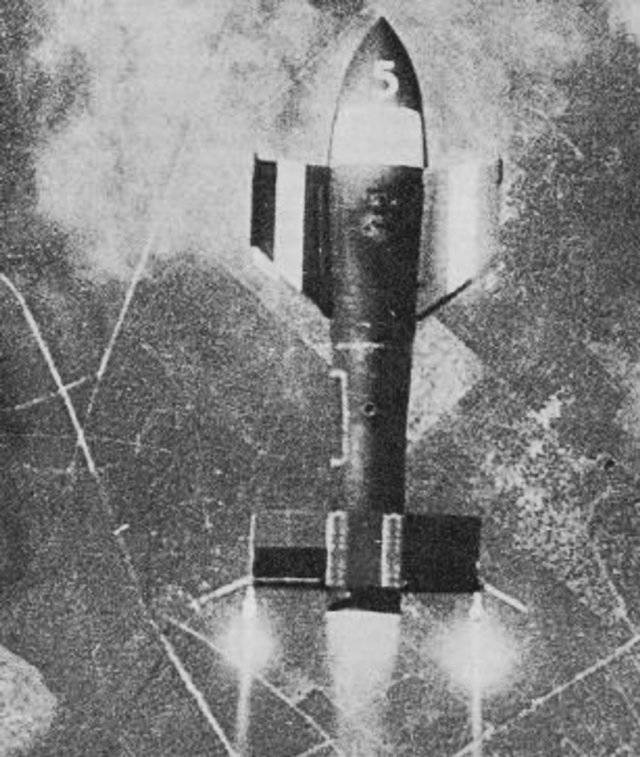
The actual low combat potential ultimately affected the fate of the entire project. November 19 43 Group III / KG100 received an order to return to Germany. There, the pilots had to learn how to use the Hs 293A bombs.
BV 226 and BV 246
Blohm & Voss was the last to join the race to create guided bombs. Project BV 226, created under the leadership of Dr. R. Fogg, had exactly the same purpose as the above. The difference was in the chosen way of implementing the idea. First of all, it is worth noting the relatively small combat weight of the bomb - 730 kilograms, 435 of which, according to the project, accounted for the warhead. At the same time, the BV 226 had a high aspect ratio hull and wing, which made it look like a glider. Several prototypes of this bomb were sent for testing in 1942. In its original form, the BV 226 project was not continued: the lack of advantages over competitors affected.
The second life of Fogg’s development was the failure of the Fritz X bomb. The very first problems of the planning ammunition from Ruhrstal forced the Luftwaffe’s management to pay more attention to alternative projects. The project of the company "Blomm und Foss" was interesting lack of strict restrictions on the height of the bomb dropping. That is why R. Fogg was instructed to improve the BV 226 and bring it to mass production. While maintaining the hull and aerodynamic contours, the BV 226 received an updated tail unit during the modernization. Instead of cruciform plumage, the bomb was equipped with a stabilizer of greater scope with keel washers at the ends. Wing large elongation received a new frame. The longitudinal wing spars were made flexible. As conceived by the engineers, the flexible wing, when the bomb was disengaged, worked like a leaf spring of a car and repelled the ammunition from the aircraft. The aerodynamic scheme applied in the BV 226 project allowed achieving aerodynamic quality of the order of 25. For comparison, the experimental aircraft Rutan Voyager had approximately the same aerodynamic quality. Thus, being dropped from a height of about a kilometer, the BV 226 was able to fly about 25 kilometers in range. Obviously, such a bomb was much more profitable than the Fritz X. The BV 226 bomb guidance system was similar to the Hs 293 and FX1400 equipment — the operator controlled the flight over the radio channel.
12 December 1943, the updated BV 226 planning bomb was put into service under the designation BV 246 Hagelkorn. He-111 and Do-217 bombers could be used as carrier aircraft for new bombs. At the very end of 43, the German pilots began to study the next guided bomb. But they failed to put it into practice - just two months after adopting the BV 246 project, it was frozen. There were several reasons. Deploying large-scale production required financial and labor costs, and there were not so many applications. Finally, the BV 246 did not have the ability to install a wired control system. Production collapsed, and already made planning bombs were used for testing to test various technologies.
At the beginning of 1945, the Reich Ministerial Ministry of Aviation requested to renew the BV 246 project in a new capacity. Now, on the basis of the planning bomb, it was necessary to make ammunition designed to destroy enemy radar stations. According to the renewed project, the use of the BV 246 bomb was to be carried out according to the “launched-forgotten” principle. For this, instead of the old radio command and control equipment, the Radieschen (“Radish”) system was installed on the bomb. This system was the most genuine semi-active radar homing head. The placement of the "Radish" required the designers to re-arrange the nose of the bomb, make a new fairing, and also move the warhead with 435 kilograms of ammotol. Even in winter, 45-th at the plant Blohm und Voss managed to collect ten prototypes of BV 246 Radieschen. During tests at the Unterless test site, bombs with passive radar seeker demonstrated the complexity of such systems. Eight out of ten bombings ended in failure: the bomb either missed the target or “left” to the ground at a great distance from the target. Only in two test launches the bombs fell at an acceptable distance from the target. Despite the low percentage of hits, the Luftwaffe wanted to get a new bomb. A contract was signed for the supply of thousands of BV 246 Radieschen, but ... The spring of 45 was already outside and no controlled bomb, regardless of the type of guidance, could stop the advance of the Red Army from the east and the allies from the west.
On the materials of the sites:
http://airwar.ru/
http://ursa-tm.ru/
http://luftarchiv.de/
http://ausairpower.net/



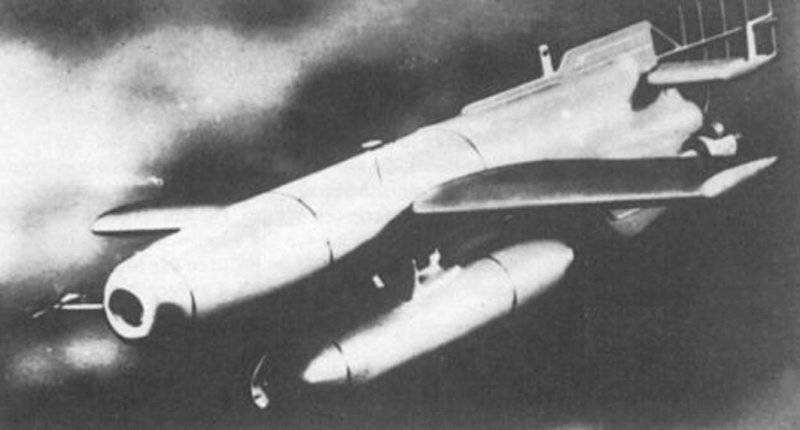
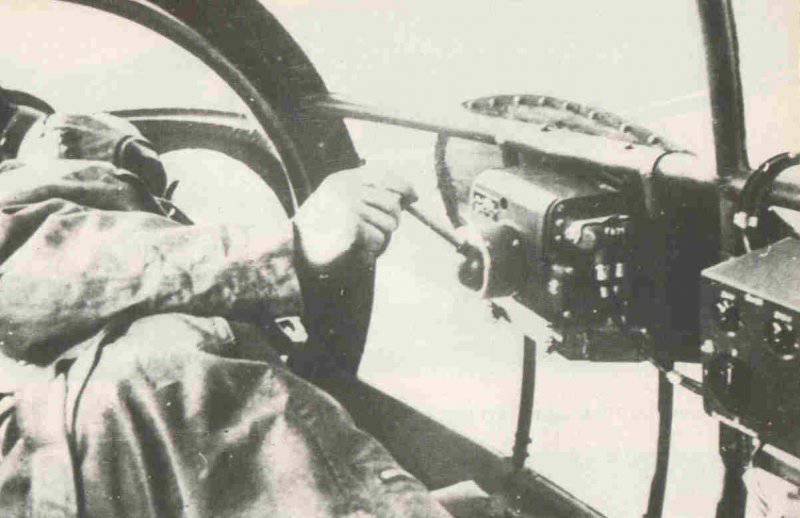
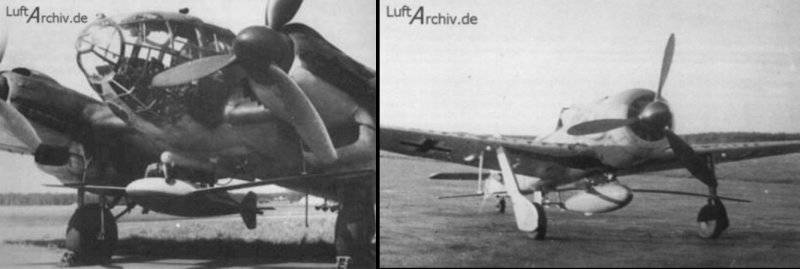
Information